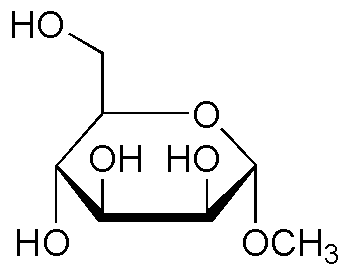Methyl-a-D-mannopyranoside is widely utilized in research focused on:
- Biotechnology: It serves as a substrate in enzyme assays, particularly for glycosyltransferases, aiding in the study of carbohydrate metabolism.
- Pharmaceuticals: This compound is used in drug formulation as a stabilizer or excipient, enhancing the solubility and bioavailability of active ingredients.
- Food Industry: It acts as a sweetening agent and flavor enhancer in various food products, providing a natural alternative to synthetic sweeteners.
- Cosmetics: Methyl-a-D-mannopyranoside is included in skincare formulations for its moisturizing properties, helping to improve skin hydration and texture.
- Research and Development: It is employed in the synthesis of glycosides, facilitating the development of new compounds for therapeutic applications.
General Information
Properties
Safety and Regulations
Applications
Methyl-a-D-mannopyranoside is widely utilized in research focused on:
- Biotechnology: It serves as a substrate in enzyme assays, particularly for glycosyltransferases, aiding in the study of carbohydrate metabolism.
- Pharmaceuticals: This compound is used in drug formulation as a stabilizer or excipient, enhancing the solubility and bioavailability of active ingredients.
- Food Industry: It acts as a sweetening agent and flavor enhancer in various food products, providing a natural alternative to synthetic sweeteners.
- Cosmetics: Methyl-a-D-mannopyranoside is included in skincare formulations for its moisturizing properties, helping to improve skin hydration and texture.
- Research and Development: It is employed in the synthesis of glycosides, facilitating the development of new compounds for therapeutic applications.
Documents
Safety Data Sheets (SDS)
The SDS provides comprehensive safety information on handling, storage, and disposal of the product.
Product Specification (PS)
The PS provides a comprehensive breakdown of the product’s properties, including chemical composition, physical state, purity, and storage requirements. It also details acceptable quality ranges and the product's intended applications.
Certificates of Analysis (COA)
Search for Certificates of Analysis (COA) by entering the products Lot Number. Lot and Batch Numbers can be found on a product’s label following the words ‘Lot’ or ‘Batch’.
*Catalog Number
*Lot Number
Certificates Of Origin (COO)
This COO confirms the country where the product was manufactured, and also details the materials and components used in it and whether it is derived from natural, synthetic, or other specific sources. This certificate may be required for customs, trade, and regulatory compliance.
*Catalog Number
*Lot Number
Safety Data Sheets (SDS)
The SDS provides comprehensive safety information on handling, storage, and disposal of the product.
DownloadProduct Specification (PS)
The PS provides a comprehensive breakdown of the product’s properties, including chemical composition, physical state, purity, and storage requirements. It also details acceptable quality ranges and the product's intended applications.
DownloadCertificates of Analysis (COA)
Search for Certificates of Analysis (COA) by entering the products Lot Number. Lot and Batch Numbers can be found on a product’s label following the words ‘Lot’ or ‘Batch’.
*Catalog Number
*Lot Number
Certificates Of Origin (COO)
This COO confirms the country where the product was manufactured, and also details the materials and components used in it and whether it is derived from natural, synthetic, or other specific sources. This certificate may be required for customs, trade, and regulatory compliance.


